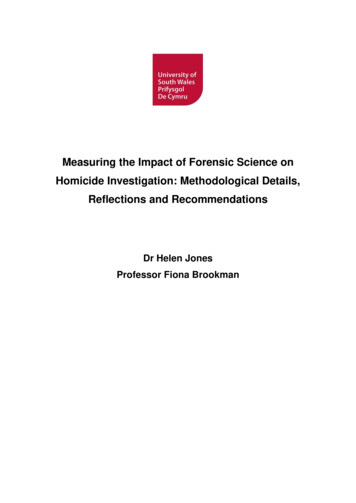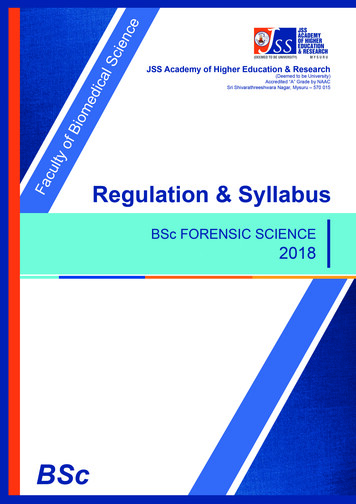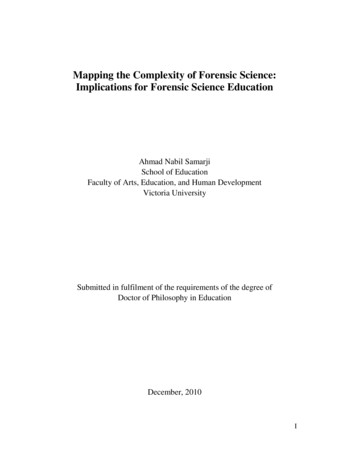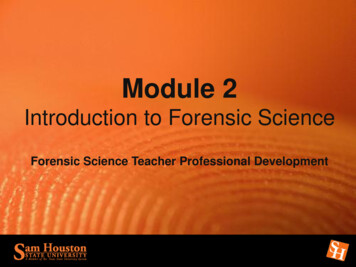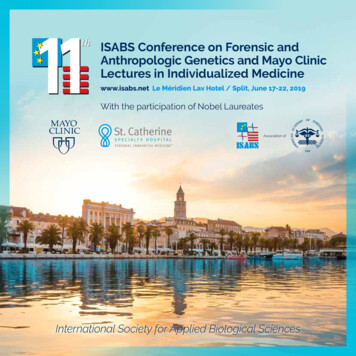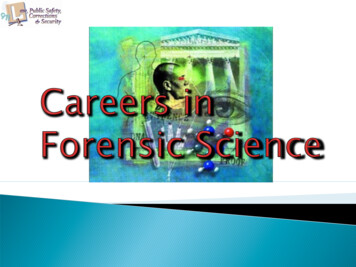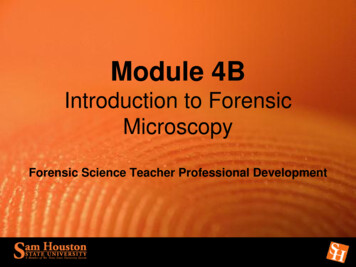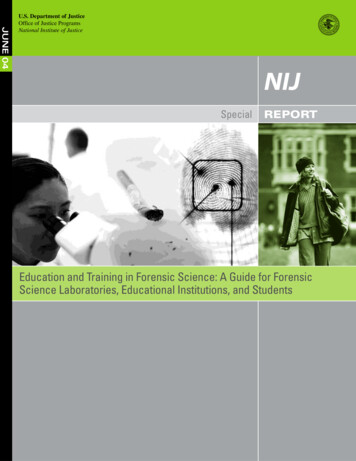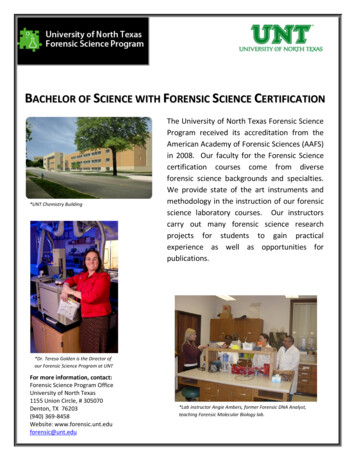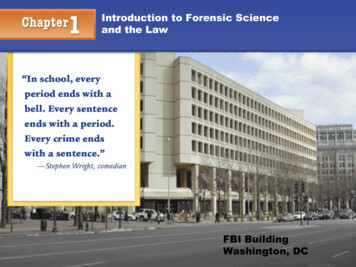
Transcription
Introduction to Forensic Scienceand the LawFBI BuildingWashington, DC1
Introduction to Forensic Scienceand the LawObjectivesYou will understand:How crime labs in the United States are organizedand what services they provide.The growth and development of forensic sciencethrough history.Federal rules of evidence, including the Fryestandard and the Daubert ruling.Basic types of law in the criminal justice system.You will be able to:Research the history of forensic science and careersin forensic science.Apply various techniques and communicate findingsused by forensic scientists to real world forensicproblems.Interpret Miranda Rights and the Bill of Rights andapply them to real world and hypothetical situations.Categorize various types of evidence based onforensic descriptors.Explain procedures used to work a crime scene.2
Introduction to Forensic Scienceand the LawForensic ScienceThe study and application of science to mattersof lawIncludes the business of providing timely, accurate, andthorough information to all levels of decision makers in ourcriminal justice systemThe word forensic is derived from the Latin forensis meaningforum, a public place where, in Roman times, senators andothers debated, performed, and held judicial proceedings.3
Introduction to Forensic Scienceand the LawCriminalistics or Criminology?CriminalisticsThe scientific examination of physical evidence for legalpurposesCriminologyIncludes the psychological angle: studying the crimescene for motive, traits, and behavior that will help tointerpret the evidence4
Introduction to Forensic Scienceand the LawBasic Services Provided by the Crime LabPhysical science unit Chemistry Physics GeologyBiology unitFirearms and ballistics unitDocument examination unitPhotography unitThe most common types of evidence examined are drugs, firearms, andfingerprints.5
Introduction to Forensic Scienceand the LawOptional Services of a Crime LabCrime labs can be government-run at the federal, state, orlocal level, or they can be private consulting businesses.Toxicology unitLatent fingerprint unitPolygraph unitVoiceprint analysis unitEvidence collection unitEngineering6
Introduction to Forensic Scienceand the LawSpecialty ServicesForensic pathology:Establishthe cause of death/perform autopsiesForensic anthropology:Cybertechnology:protectsnetworks, computers, programs, anddata from attack.Studyhuman remains to determine cause ofdeathGeology: connects earth scienceForensic entomology: Study ofEnvironmental science: Usesinsects and other arthropodsa combination of analytical andenvironmental chemistry to examineevidence.Forensic psychiatry: Makeassessments about the mental health ofpeople and provide a means oftreatmentForensic odontology:Study ofwith criminologyPalynology:Study of pollen andpowdered minerals to determine that abody or object was in a certain placeat a certain time.dental structuresForensic engineering:investigation of materials, products,structures or components that fail or donot operate or function as intended.Polygraphy: Administering the Liedetector testVoiceprint analysis:Interpretation of listening andvisualizing one’s voice7
Introduction to Forensic Scienceand the LawFederal Crime LabsFBI: Federal Bureau of InvestigationDEA: Drug Enforcement AgencyATF: Alcohol, Tobacco, and FirearmsUSPS: United States Postal ServiceU.S. Fish and Wildlife ServiceDepartment of Homeland SecurityDepartment of the Treasury8
Introduction to Forensic Scienceand the LawThe Locard PrincipleEdmond Locard (1877–1966)French professorConsidered the father of criminalisticsBuilt the world’s first forensic laboratory inFrance in 1910Locard Exchange Principle:Whenever two objects come into contactwith each other, there is always a transferof material.9
Introduction to Forensic Scienceand the LawCrime Scene TeamA group of professional investigators, each trained in a varietyof special disciplinesTeam members:First police officer on the sceneMedics (if necessary)InvestigatorsMedical examiner or representative (if necessary)Photographer and/or field evidence technicianLab experts:pathologistDNA expertforensic odontologistforensic psychologistfirearm examinerdocument and handwriting expertsserologisttoxicologistforensic anthropologistforensic entomologistbomb and arson expertsfingerprint expert10
Introduction to Forensic Scienceand the Law11
Introduction to Forensic Scienceand the LawScientific Method(as it pertains to criminalistics)A. Observe a problem or questioned evidence and collectobjective data.B. Consider a hypothesis or possible solution.C. Examine, test, and then analyze the evidence.D. Determine the significance of the evidence.E. Formulate a theory based on evaluation of thesignificance of the evidence.12
Introduction to Forensic Scienceand the LawTypes Constitutional law: Study, practice, andinterpretation and administration of laws setforth by the constitution. Statutory law: Written law set down by alegislature Common law or case law: Made by judgesthat interprets or refines statutes andconstitutions. Civil law: Law of citizens’ rights Criminal law: Branch of the law dealing withcrimeof Law Equity law: form ofresolution in which anaggrieved party isasking his opponent forsomething other thanmoney (judge-ordered) Administrative law:Law dealing with theaffairs of agencies ofthe executive branch ofa government.13
Introduction to Forensic Scienceand the LawThe Bill of RightsGives individuals the right: To be presumed innocent until proven guilty Not to be searched unreasonably Not to be arrested without probable cause Against unreasonable seizure of personal property Against self-incrimination To fair questioning by police To protection from physical harm throughout the justice process To an attorney To trial by jury To know any charges against oneselfHow does it pertain to forensics?14
Introduction to Forensic Scienceand the LawMiranda RightsThe following is a minimal Miranda warning:You have the right to remain silent. Anything you say can andwill be used against you in a court of law. You have theright to speak to an attorney, and to have an attorneypresent during any questioning. If you cannot afford alawyer, one will be provided for you at the government’sexpense.15
Introduction to Forensic Scienceand the LawTypes of CrimesInfraction: minor offense or petty crime;penalty is usually a fineMisdemeanor: minor crime punishable byfine or jailFelony: major crime punishable by finesand/or more than one year in prison16
Introduction to Forensic Scienceand the LawFederal Rules of EvidenceIn order for scientific evidence to beadmitted in a court of law, it mustbe:Probative: actually provessomethingMaterial: addresses anissue that is relevant tothe particular crime17
Introduction to Forensic Scienceand the LawAdmissibility of EvidenceThe Frye StandardFrom the 1923 case Frye v. United StatesScientific evidence is allowed into thecourtroom if it is generally acceptedby the relevant scientific community.The Frye standard does not offer any guidanceon reliability. The evidence is presented in thetrial and the jury decides if it can be used.18
Introduction to Forensic Scienceand the LawAdmissibility of EvidenceThe Daubert RulingFrom the 1993 case Daubert v. DowThe judge decides if the evidence can be entered into the trial.Admissibility is determined by:Whether the theory or technique can be testedWhether the science has been offered for peer reviewWhether the rate of error is acceptableWhether the method at issue enjoys widespread acceptanceWhether the theory or technique follows standards19
Introduction to Forensic Scienceand the LawThe Expert WitnessThe expert witness presentsscientific evidence in court.He/She will:Establish credibility through credentials,background experience.Evaluate evidence.Render an opinion about the evidence.The judge may accept or reject theopinion’s significance.20
Introduction to Forensic Scienceand the LawFacets of GuiltTo prove a case, the “MMO” must be established; it mustbe shown that the suspect had:Motive—person had a reason to do the crime (not necessary toprove in a court of law)Means—person had the ability to do the crimeOpportunity—person can be placed at the crime scene21
The growth and development of forensic science through history. Federal rules of evidence, including the Frye standard and the Daubert ruling. Basic types of law in the criminal justice system. You will be able to: Research the history of forensic science and careers in forensic science. Apply various techniques and communicate findings
